Namibia’s Leading Environmental and Social Impact Assessment (ESIA) Service Provider
The Namibian Environmental Management Act (EMA), No. 7 of 2007 requires any person who wishes to undertake a listed activity to apply for and receive an Environmental Clearance Certificate (ECC) from the Ministry of Environment, Forestry and Tourism’s (MEFT’s) Department of Environmental Affairs (DEA) before such activities can be undertaken.
A critical step in the ECC application process for any project Proponent, is hiring a qualified Environmental Assessment Practitioner (EAP) to conduct a comprehensive Environmental and Social Impact Assessment (ESIA) — sometimes termed an Environmental Impact Assessment (EIA) when limited social impact assessment is predicted — on the Proponent’s behalf.
Read on to learn more about Namibia’s ECC application process as well as why Environmental Compliance Consultancy — Namibia’s industry-leading EAP — is best suited to manage your project’s ECC application and renewal processes.
A Note on Environmental Management Acronyms
Because acronyms are rife in the environmental management industry, please use the reference table below to help decipher any commonly used acronyms you’re not familiar with:
| ACRONYM | MEANING |
| BID | Background Information Document |
| DEA | Department of Environmental Affairs |
| EAP | Environmental Assessment Practitioner |
| EC | Environmental Commissioner |
| ECC | Environmental Clearance Certificate |
| ECC | Environmental Compliance Consultancy |
| EIA | Environmental Impact Assessment |
| EMA | Environmental Management Act (No.7 of 2007) |
| ESIA | Environmental and Social Impact Assessment |
| EMP | Environmental Management Plan |
| I&AP | Interested & Affected Party |
| MEFT | Ministry of Environment, Forestry and Tourism |
| MICT | Ministry of Information and Communication Technology |
| MME | Ministry of Mines and Energy |
| MoT | Ministry of Transport |
| ToR | Terms of Reference |
What is an Environmental Assessment Practitioner (EAP)?
EAPs are qualified environmental professionals who possess a deep understanding of Namibia’s EMA and other relevant legislation governing EMA listed activities.
It is the responsibility of listed activity proponents to appoint an EAP at their own expense so the EAP can then manage the ESIA and ECC application process on a proponent’s behalf.
Environmental Compliance Consultancy is Namibia’s leading EAP and is available to conduct ESIAs for all listed activities in the following industries:
- Energy
- Mining & Minerals
- Agriculture & Forestry
- Conservation & Tourism
- Infrastructure & Construction
What’s more, Environmental Compliance Consultancy’s methodologies incorporate the following international standards:
- International Organization for Standardization (ISO)
- International Finance Corporation (IFC)
- Equator Principles (EPS)



What Are EMA Listed Activities?
Listed Activities are those projects which Namibia’s EMA and its regulations stipulate that an ECC is required before operations can begin.
For quick reference, listed activities include operations related to the following:
- Energy Generation, Transmission and Storage Activities
- Waste Management, Treatment, Handling and Disposal Activities
- Mining and Quarrying Activities
- Forestry Activities
- Land Use and Development Activities
- Tourism Development Activities
- Agriculture and Aquaculture Activities
- Water Resource Development Activities
- Hazardous Substance Treatment, Handling and Storage Activities
- Infrastructure Activities
- Other Activities such as the Construction of Cemeteries, Camping, Recreation and Military Sites
To view Namibia’s full list of activities that require an ECC as stipulated by the EMA, click here.
What Is the ESIA and ECC Application Process?
In Namibia, the ECC application process comprises 8-stages that culminate in the submission of an ESIA report, an Environmental Management Plan (EMP), and a decision by Namibia’s Environmental Commissioner (EC) as to whether or not an ECC will be granted, and if so, what conditions need to be met for continued approval.
The 8-stages comprising the ECC application process include:
- Stage 1: Project Screening
- Stage 2: Establishing the ESIA Scope
- Stage 3: Conducting Baseline Studies
- Stage 4: Preparing the Scoping Report and EMP
- Stage 5: Impact Identification and Evaluation
- Stage 6: Draft & Finalise the ESIA & EMP
- Stage 7: Authority Assessment & Decision
- Stage 8: Project Monitoring & Auditing
Keep scrolling to learn more about each of these 8 ECC application stages…
Stage 1: Project Screening
After an EAP has been hired by the project Proponent, the first stage in the ECC application process starts with undertaking a screening exercise that will determine if the project in question triggers any listed activities under Namibia’s EMA, 2007 and its regulations.
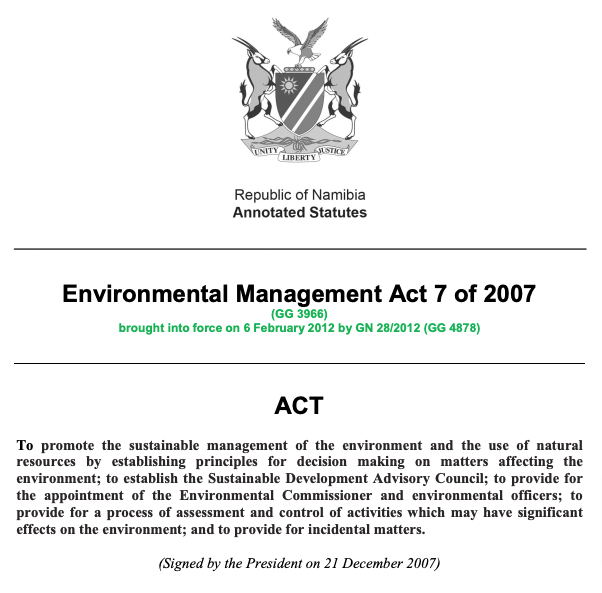
The screening phase is a preliminary analysis to determine ways in which a project might interact with Namibia’s biophysical, social, and economic environments.
Action steps and stakeholder engagement required at this stage include:
- Registration of the project on the MEFT Portal
- Completing and submitting MEFT Form 1
- Preparation of the project’s Background Information Document (BID) for MEFT, Stakeholders, and any Interested & Affected Parties (I&APs) (See our current list of Projects for examples)
- Paying the appropriate registration fee (currently N$300) and proving Proof of Payment via revenue stamps.
- Your EAP then uploads the project description and BID to their website to begin the stakeholder and I&AP engagement process.
Stage 2: Establishing the ESIA Scope
The second stage of the ECC application process is to establish the scope of the assessment required.
The main aim of this stage is to:
- Determine which environmental and social impacts are likely to be significant
- Scope the relevant data currently available
- Determine any data gaps that must be addressed
- Determine the spatial and temporal scope of the assessment
- Identify the assessment methodology that will be applied
The assessment scope is determined through undertaking a preliminary assessment of the proposed project against the receiving environment. Feedback from consultation with both the public and project Proponent informs this process.
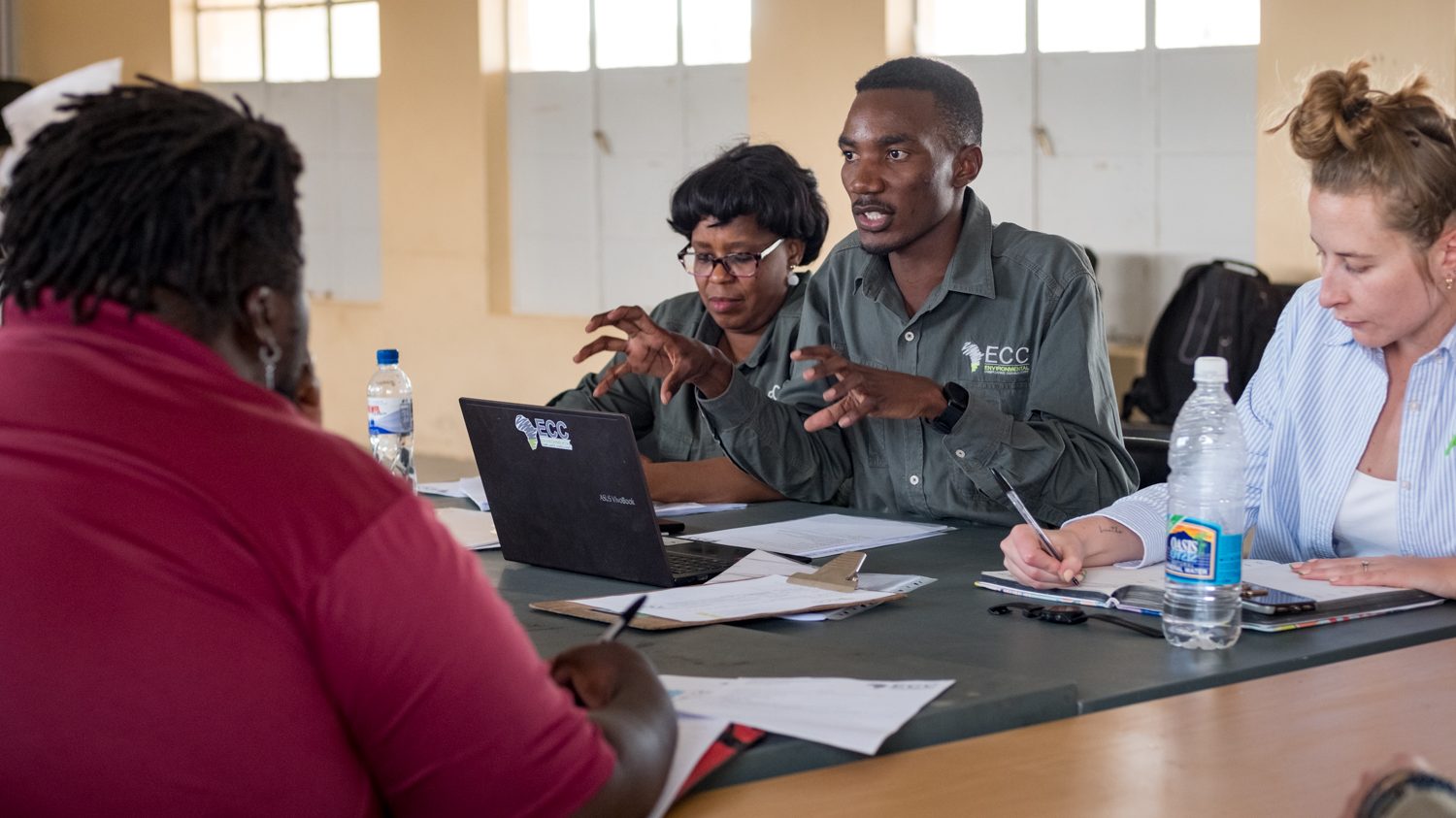
Various Biophysical, Social and Economic topics can be scoped into the assessment if the potential for significant impacts are identified in the preliminary assessment. These topics can include:
Biophysical Environment:
- Air Quality
- Ambient Noise
- Avifauna
- Ecosystem Services
- Groundwater
- Soils and Geology
- Surface Water
- Terrestrial Ecology Fauna
- Topography and Landscape
- Vibration
- Visual
Social Environment:
- Community health, safety and security (off-site & on-site)
- Cultural Heritage
- Employment and Livelihoods
- Human Rights
- Local Community Demographics
Economic Environment:
- Infrastructure
- Land Use
- Socio Economic / Economy
- Tourism
- Traffic and Transport
Impacts identified as potentially significant during the screening phase (Stage 1) and Scoping phase (Stage 2) are taken forward for further assessment in the ESIA process.
Stage 3: Conducting Baseline Studies
Next, a robust baseline study is required to establish reference points against which any future changes associated with a project can be assessed, as well as to allow suitable mitigation and monitoring to be identified.
The surrounding region and general area of the project will be examined for the baseline study and any relevant literature will then be included and referenced.
Next, the specific site area for a proposed project will be studied in detail with the following work often conducted:
- Desktop studies
- Field surveys
- Consultation with stakeholders
- Specialist field visits
- Monitoring
- Ongoing studies
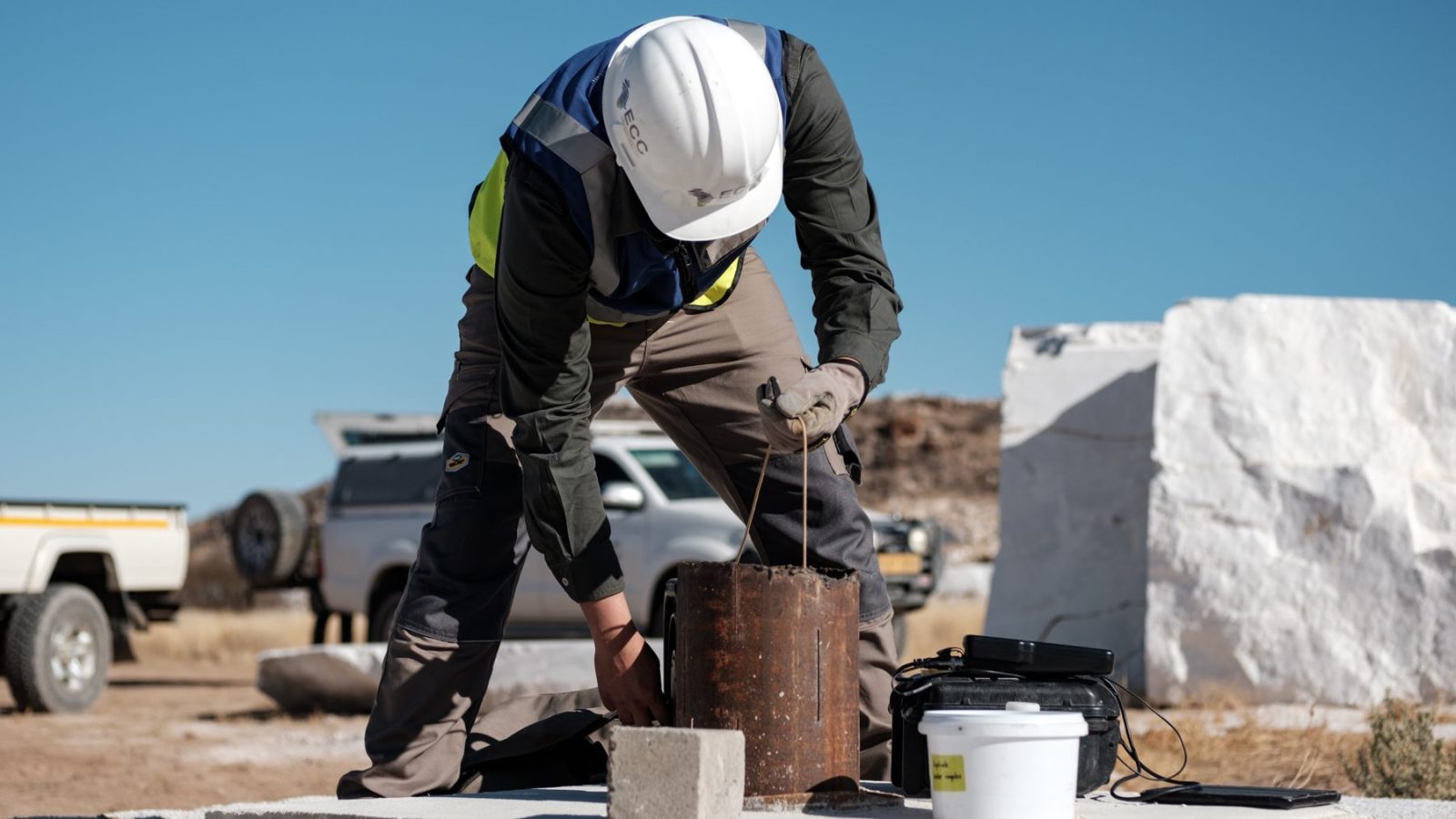
Once environmental and social baselines are established (Stage 3), they will be used in Stage 4 – preparing the Scoping Report.
Stage 4: Preparing the Scoping Report and EMP
Based on the work of Stages 1-3, a scoping report will be produced to document all findings to this point while also providing stakeholders the opportunity to comment as part of the ongoing consultation that forms part of the environmental assessment.
The scoping report will focus on describing the ESIA process, the project description, the baseline description and the Terms of Reference (ToR) for the assessment phase.
Once finalised, the scoping report will be issued to both stakeholders and I&APs for consultation, for a minimum of 7 days, as prescribed in the EMA.
The aim of this stage is to ensure that all stakeholders and I&APs have an opportunity to provide comments on the assessment process, and to register their concerns, if any.
Concurrently, your EAP will also draft an Environmental Management Plan (EMP) that will not only provide measures to manage the environmental and social impacts of the project, but to also outline the specific roles and responsibilities required to fulfil that plan.
Stage 5: Impact Identification and Evaluation
The impact identification and evaluation stage (Stage 5) is a critical step in the ESIA & ECC application process.
This stage evaluates the project’s characteristics against the environmental and social baseline environmental characteristics to ensure all potentially significant environmental and social impacts are identified, appropriately risked and addressed through mitigation plans.
This is an iterative process that actually commences at project inception and ends with the final design and project implementation. The impact identification and evaluation stages will be updated in the assessment phase.
The final design of the proposed project will be assessed, along with any alternatives considered during the design process in accordance with the EMA.
Here at Environmental Compliance Consultancy, the methodology used to assess a project against the environmental and social baselines are also determined at this stage using our proprietary Impact Prediction and Evaluation Method shown below:
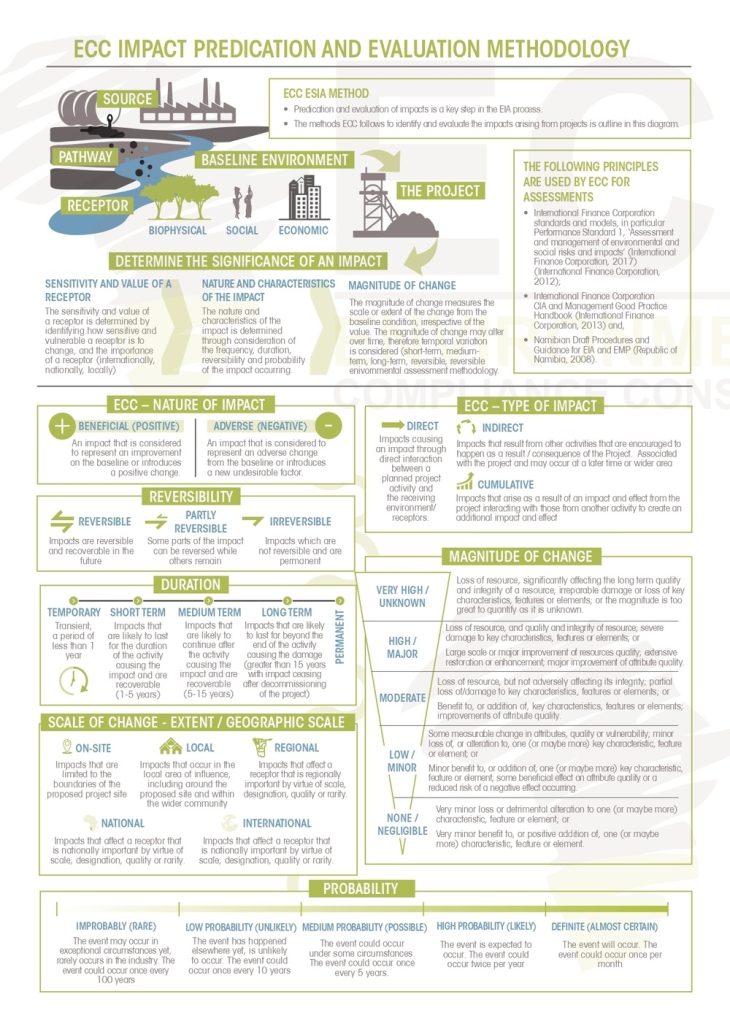
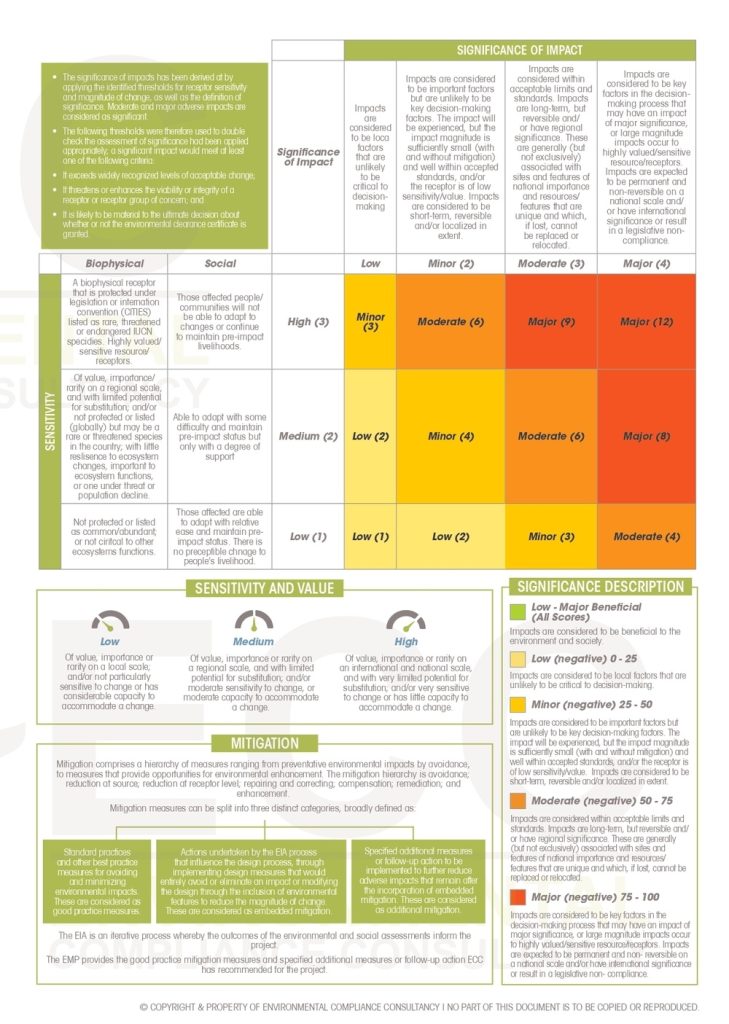
Stage 6: Draft & Finalise the ESIA & EMP
In Stage 6, the final ESIA and EMP reports will now be drafted.
All comments received during the I&AP public review period in Stage 4 will be now be collated in an addendum report, which will accompany the final ESIA report when submitted to the MEFT: DEA as well as any other relevant authority (e.g. the MME, MoT, MICT, etc.).
All comments will be responded to, either by providing an explanation, further information, or by signposting where information exists or has been included in the ESIA report or appendices.
Comments will be considered, and where they are deemed to be material to the decision-making process, or might enhance the ESIA, they will be incorporated.
The final ESIA, its appendices and any addendum reports will be available to all stakeholders, and all I&APs will be informed of its availability for review.
Stage 7: Authority Assessment & Decision
After Stages 1-6 are completed, the ECC application — which includes the ESIA report, its appendices and addendum reports, as well as the EMP — is ready to submit to MEFT (via the EC within the DEA), as well as to any other relevant authorities such as the MME, MoT and MICT.
The EC, in consultation with the other relevant authorities, will assess if the findings of the ESIA and ECC application submitted are acceptable.
Please note that the EC can take up to 3 months after submission to issue an ECC decision, so it is imperative to begin your ESIA and ECC application process as soon as possible.
If deemed acceptable, the EC will revert to the project’s Proponent with a record of their approval decision as well as any further requirements and recommendations necessary to maintain a project’s ECC approval. These requirements and recommendations are usually printed on the back of the ECC approval document and may include such actions as submitting bi-annual reports, instructions on what to do if heritage objects are discovered, etc.
Stage 8: Project Monitoring & Auditing
Finally, after an ECC approval for a project has been issued, and in addition to the EMP being implemented by the Proponent, a monitoring strategy and audit procedure must be established by the project Proponent and competent authority.
The monitoring strategy and audit procedure established will ensure key environmental receptors are monitored over time to detect any significant changes from the baseline environmental conditions caused by a project’s activities.
Thorough monitoring and successful audit compliance are key to show relevant authorities that the ECC and EMP commitments are being met, otherwise continued approval and renewal of a project’s ECC will not be granted.
ECC Renewal Process
Depending on the length of you or your organisation’s listed activity project, a renewal of the project’s ECC may need to be applied for.
Often, ECC approvals are issued for 3 years, and if continued operations are required after that 3 year period, renewal applications must be submitted in the 90 days prior to expiry.
ECC renewal applications usually require submitting the following to MEFT’s DEA and any other relevant authorities:
- A renewal application form with an attached cover letter
- An updated project EMP
- Any required compliance reports
- All applicable renewal application fees
Luckily, submitting a brand new ESIA is usually not required as part of ECC renewal process.
Choosing the Right Environmental Assessment Practitioner for Your Project
After reading the above, it’s clear that the competency and capabilities of the EAP you choose to manage your project’s ESIA and ECC application process is crucial when it comes to receiving a successful approval decision from the EC.
That’s why you should never leave such critical work to chance.
Contact Environmental Compliance Consultancy for your next listed activity project so we can prove why we’re the best in the business.
We staff experts and serve clients from a broad range of industries including:
- Energy
- Mining & Minerals
- Agriculture & Forestry
- Conservation & Tourism
- and Infrastructure & Construction
If you or your organisation plans to conduct a listed activity in Namibia and wish to give your ECC application the best possible chance of success, contact Environmental Compliance Consultancy today.

